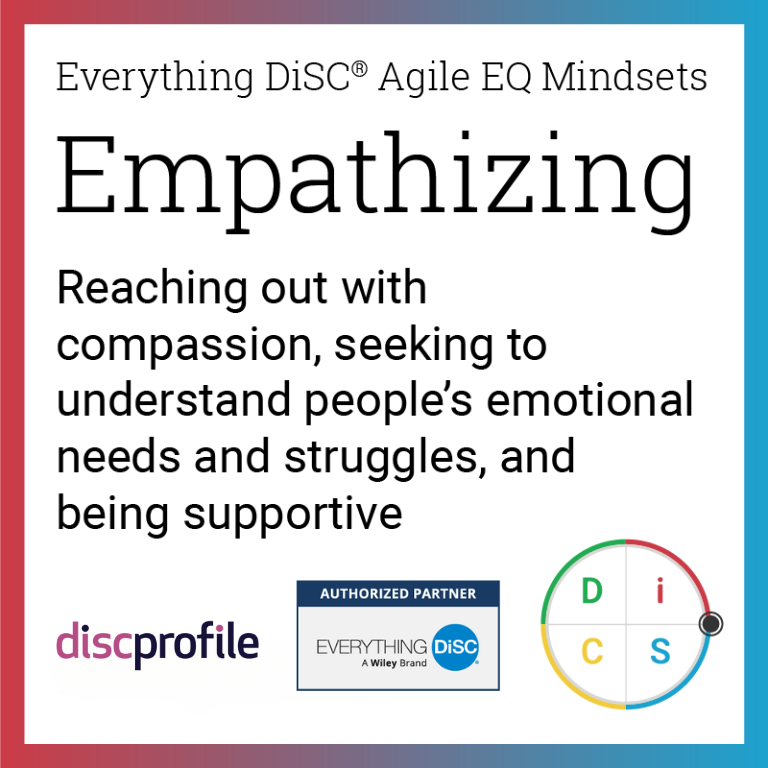How to Be More Empathetic

Do you find it takes effort to show empathy at work? For some people, an empathetic personality comes naturally. For others, empathy takes a lot of effort and energy. If you'd like to learn how to be more empathetic at work, there are ways to practice this skill.
Key Takeaways
- People with empathetic personalities care deeply about other people and prioritize compassion.
- People of all personality types may want to call upon the empathetic mindset when they need to relate better to others and make people feel safe.
- You can practice being more empathetic by recognizing the thoughts standing in your way, setting goals, and practicing.
- Practice empathy by offering support, learning to anticipate what people need, and attending to other people's emotional needs, among other tips.
Everyone has mindsets that come more easily to them, and mindsets that take more energy to employ. When you're running on your “default setting,” it can be hard to remember there are other mindsets you could call upon.
What is an empathetic personality?
“I notice how others are feeling.”
Naturally empathetic people prioritize compassion, caring deeply about the needs and emotions of others. They pay attention to nonverbal cues and notice when someone is upset. They know that everyone is going through something, and direct their energy toward understanding and offering support.
Empathizing people are generally great listeners. They don't just nod their heads—they consider what the words mean and reserve judgment.
Individuals with empathy see the best in people. They draw others out with their warm, accepting demeanor. This contributes to a supportive environment where people aren’t afraid to speak up about their concerns.
Everything DiSC® Agile EQ™
Which needs drive empathetic people?
People with natural empathy feel fulfilled when their support can make a real difference in someone else’s life. They feel valuable when they make others feel valuable. People who are naturally empathizing feel comfortable in that mindset because it allows them to meet their core needs. These are things like:
- connection
- acceptance
- strong relationships
- harmony
- a caring, friendly environment
- being helpful
- providing emotional support
Benefits of an empathetic mindset
Innate empathy tends to align with folks on the iS and Si side of DiSC®. However, it is a frame of mind that is available to everyone to call upon when the situation is right for it. Seeing things from another person's point of view is key to improving your emotional intelligence.
Whatever your personality style, an empathetic mindset allows you to:
- relate better to others
- develop stronger relationships
- notice verbal and nonverbal cues that something isn’t right
- stay open to the concerns of others
- be respectful of other perspectives
- contribute to a supportive environment that makes people feel safe
- gain a fuller picture of an issue, leading to better choices and results
Although the empathizing mindset focuses so much on helping others, it can also help the person practicing it. The advantages will differ for people of different DiSC styles. For example, empathy can:
- make D styles more approachable
- C styles less likely to get frustrated with others, and
- S styles less reserved.
In discussing the strategic importance of empathy, Stanford University’s Ed Batista talks about how most conflict stems from misunderstandings. He invokes a line from Jean Renoir’s film The Rules of the Game: “The awful thing about life is this: everyone has their reasons.”
Working to understand others helps explain why a person is acting a certain way. This understanding builds stronger teams.
Limitations of an empathetic mindset
If you’re a naturally empathizing person, it has probably served you well in many situations. But all mindsets have their limitations and can suffer from overuse. You face different situations every day. It’s unlikely that one way of thinking works best for all of them.
If you get stuck in the empathetic mindset, you might:
- minimize your own needs to attend to those of others
- be too lenient, excusing poor behavior or performance
- overextend yourself
- allow your judgment to be compromised
- try to soothe or pacify someone when a different response would be more helpful
- take on someone else’s work if they seem stressed out, which can create unhealthy dynamics and patterns
Situations that may call for empathy
When is an empathetic mindset the right choice? Part of the development that happens when using Everything DiSC® Agile EQ™ is learning agility—the ability to read a situation and recognize which mindset is needed. The empathizing mindset will be useful to different people under different circumstances, but in general, you may need to call upon empathy when:
- trying to understand someone else’s motivations or behavior
- supporting a coworker who is struggling
- anticipating how your actions might impact others
- being approachable
- gaining deeper knowledge of another person
- creating a respectful environment
- looking for the full picture on an issue
- encouraging others to open up

How to be more empathetic
You can learn to develop empathy. It is a skill you can practice over time, not just an innate, unchangeable quality that you either have or you don’t.
Yes, some people are naturally empathetic. However, everyone can learn to feel more comfortable using empathy. It will just take more effort for you if it’s not one of your natural mindsets.
We recommend taking the Everything DiSC® Agile EQ™ assessment to see where your “effort meter” is for the empathizing mindset (see sample profile). Agile EQ reports are highly personalized, but here is some general guidance for those wishing to practice empathy.
Recognize your thoughts
Based on your DiSC style and effort meter, Agile EQ will walk you through ways to gain skills in the mindsets not innate to you. This starts with recognizing and challenging automatic thoughts that make it hard for you to stretch into a mindset. For the empathizing mindset, these may be thoughts such as:
- I need to get out of this conversation as quickly as possible.
- They’d probably rather just be left alone.
- It’s not my job to coddle people, especially at work.
- I’ve got more important things going on.
- How hard is it to get this right?
- If I don’t say the right thing, I might make this worse.
Set goals
Then, you’ll set beginner, intermediate, and advanced goals based on where you’re at with the mindset. These may be outcomes like:
- I regularly check in with people to see if they need help.
- I almost always feel comfortable talking with someone who is upset or emotional.
- I often think about what kinds of support different people need from me.
- If someone frustrates or bothers me, I typically stop and consider things from their perspective.
Start practicing
Everyone’s path toward empathy will look different, but here are some general tips to be more empathetic:
- Reach out to offer support to colleagues who need it.
- Take time to attend to others’ emotional needs.
- Check in with colleagues regularly to see how they are.
- Adapt your approach to different people and situations.
- Learn to anticipate what people need from you.
- Engage with others about their problems, even if things get tense or emotional.
If the empathizing mindset is not intuitive for you, practicing it will likely cause some discomfort. Keep an open mind and remember that progress comes in small steps.
Growing your emotional agility
Once you know the mindsets you usually use, it’s important to learn about the other Agile EQ mindsets too. This helps you understand your coworkers' motivations better. It also lets you try new responses, even if they require more effort.
Emotional intelligence is not something mysterious and abstract. Research shows that people can develop this skill with practice.
To improve your emotional intelligence (EQ), consider using Agile EQ. It can help guide your talks with a leadership coach, mentor, or accountability partner. It can be exciting to realize there are many options. This can empower you in any situation.
Recent research shows that 80 percent of people have worked on a team where low EQ hurt productivity or created a toxic culture. By developing your agile emotional intelligence, you’ll become a greater asset to your organization, be a better teammate, and experience less stress yourself.
Posted 08/08/2020, Last Updated 12/26/2024







